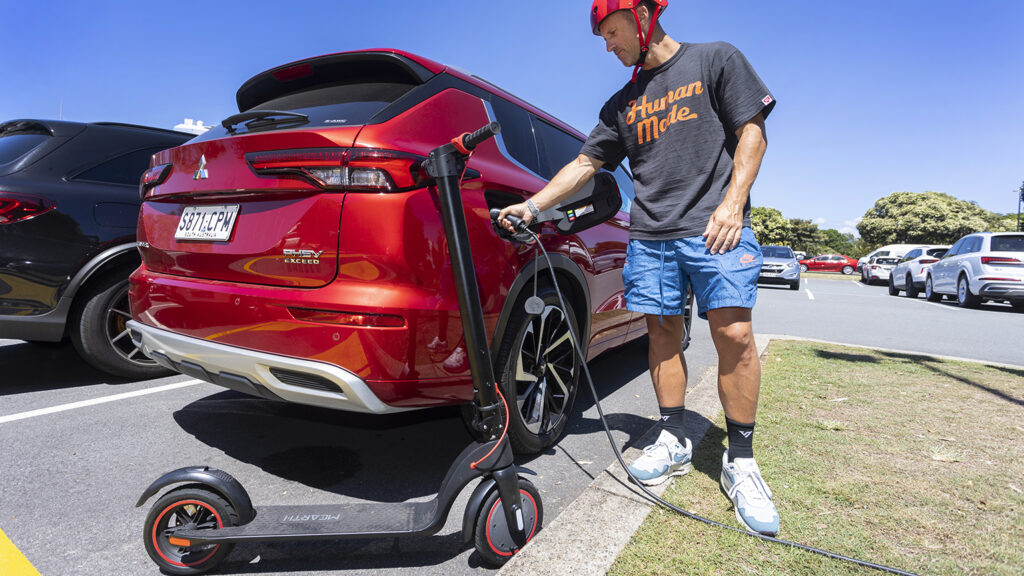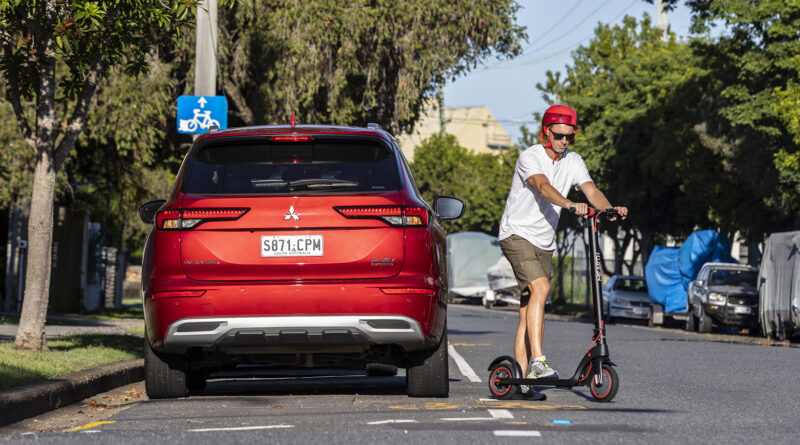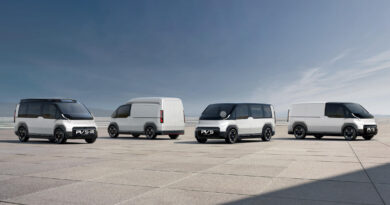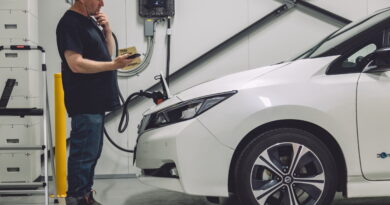An e-scooter, a PHEV and an angry man
I despise electric scooters. A lot.
Thinking about it, it’s not the scooters drawing my ire. It’s the mugs who tend to ride them.
Sure, there are e-scooter riders who do the right thing. But many – and an ever increasing number – seem to spend their scoot time auditioning for Darwin Awards.
No helmet. On their phone. Launching off steps. Carrying their mate or child. Breaking the speed limit. Sometimes all of the above at once.
And for extra points, some add being drunk or high to expedite their (and potentially others’) trip to the emergency room.
Urban saviour or public menace?
It’s actually a massive bloody shame. E-scooters should be a force for good.
If you scoot into towns and cities, that’s a congestion-causing car off the road. And there are zero emissions if you recharge a scooter’s batteries from a sustainable source.
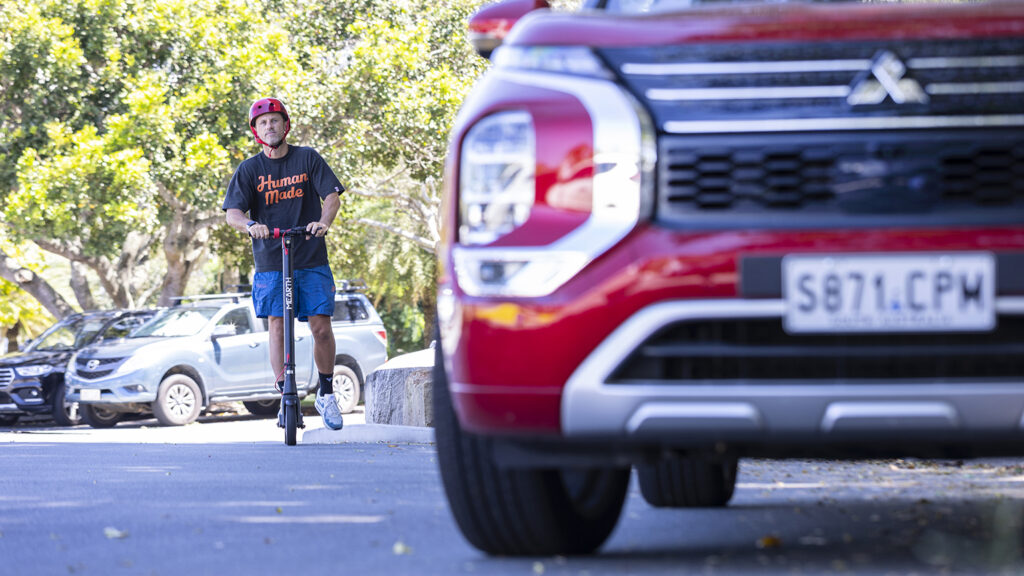
They don’t take up much room, are easy to maintain and can be bought for not a lot of money. Hence why so many pesky kids got one for Christmas.
And, okay, some catch fire and burn down apartment blocks, but nobody said the revolution would be easy.
Used in the right way, an e-scooter is a compelling transport solution for those not keen or able to cycle or walk to their ultimate destination.
There’s the ‘last mile’ concept. Here, we leave our cars on the edge of town where there’s (hopefully) ample parking, then bust out the e-scooter and zip the last mile (or 1.6 kilometres) into the urban jungle.
Reality is, we can scoot a lot further than that. Some e-scooters have a range around the 100km mark, although 20-50km is more typical. It means you can travel, should you wish, a substantial distance between charges. Or, more likely, if your ‘last mile’ commutes are short, you may need only recharge once a week.
And, if the idea of taking an e-scooter to your home power point sounds too much like hard work, V2L (or vehicle-to-load) technology makes life even easier.
Basically, if your electric car or plug-in (PHEV) vehicle has V2L tech, it has built-in bi-directional charging and an AC power outlet.
This means you can power or charge AC appliances with a three-pin plug from your car’s (far larger) battery. Just plug in your microwave, TV, coffee machine, laptop, fridge, e-scooter, e-bike or whatever, and the car sends electric juice their way.
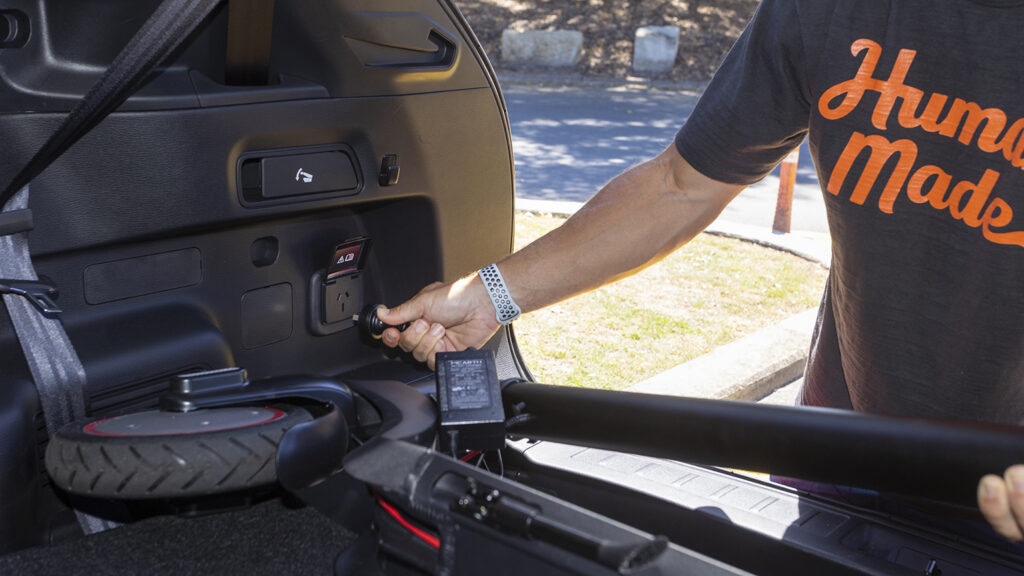
A Mitsubishi PHEV / E-scooter partnership?
EVs with V2L include the Hyundai Ioniq 5 and Ioniq 6; Kia EV6 and Niro EV; MG ZS EV, all electric Genesis’ and the BYD Atto 3.
Rather wonderfully, Mitsubishi’s Outlander PHEV now has V2L in all but the entry-level model too. The team at Mitsubishi Australia has found an electric scooter that fits snugly in the seven-seater’s boot floor – handily right by one of its two plug points – and is evaluating the potential for offering an ‘optional extra’ e-scooter to customers.
Potentially not aware of my disdain for e-scooters, Mitsubishi asked if I’d like to test it out. As it’s the suicidally-speeding helmet-free riders I loathe and not the scooter itself, I agreed to give it a crack.
The e-scooter’s a Mearth S entry-level offering, which retails for around $560. See it more as the MG3 of the e-scooter world, rather than a Porsche 911.
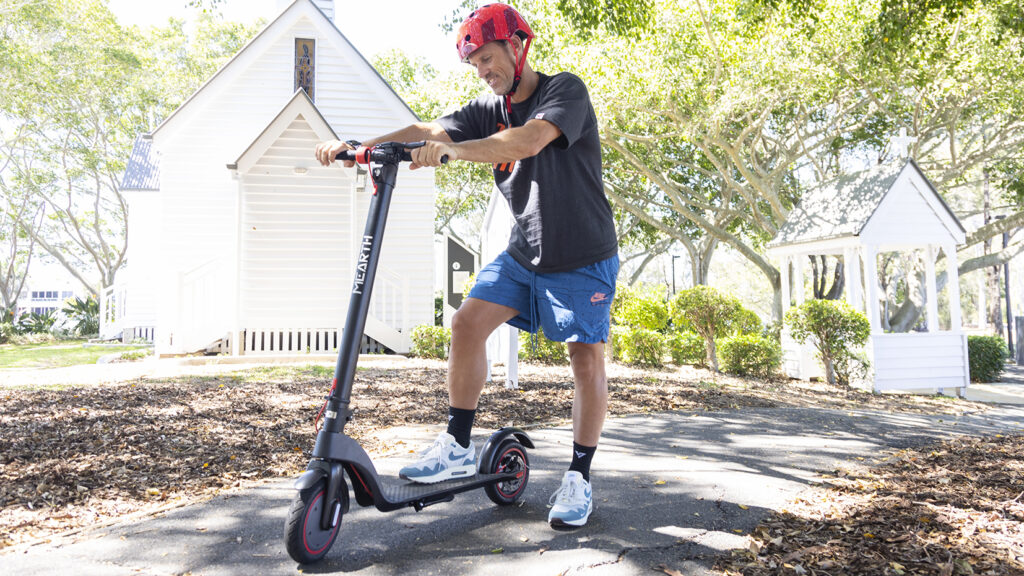
It has a 350W electric motor, 180Wh battery and maximum range between 15-25km. You can pay another $150 for a Pro version with double the battery size and range from 30-45km.
Its charging time is 3-4 hours, there’s a top speed of 32km/h and it weighs 12.5kg. Once lifted from the boot, the stem folds out and locks into place pretty easily, so you’re away in just a few seconds.
Testing on Gold Coast’s packed streets
We were visiting the Gold Coast with its congested nightmare of roads, and as this was Real World Testing, I found a free car park about 4km from our downtown hotel. I ditched the Outlander PHEV here and saddled up the e-scooter.
The benefits were already mighty. I’d not had to drive into a busy urban area, nor search for a car park or parking space, nor pay their exorbitant fees. I also didn’t have to hop on public transport, if that’s not your thing.
This is all very appealing if you work or have a meeting in the city, as long as there’s somewhere to safely park / chain the e-scooter. Packed day at the beach with zero parking spots? Take the e-scooter the last few kilometres instead of the car.
Riding the e-scooter doesn’t require Olympic-level skills. You just need a bit of road sense, basic balance, and smarts enough to put a helmet on and stick to the road rules (see end of this article for those).
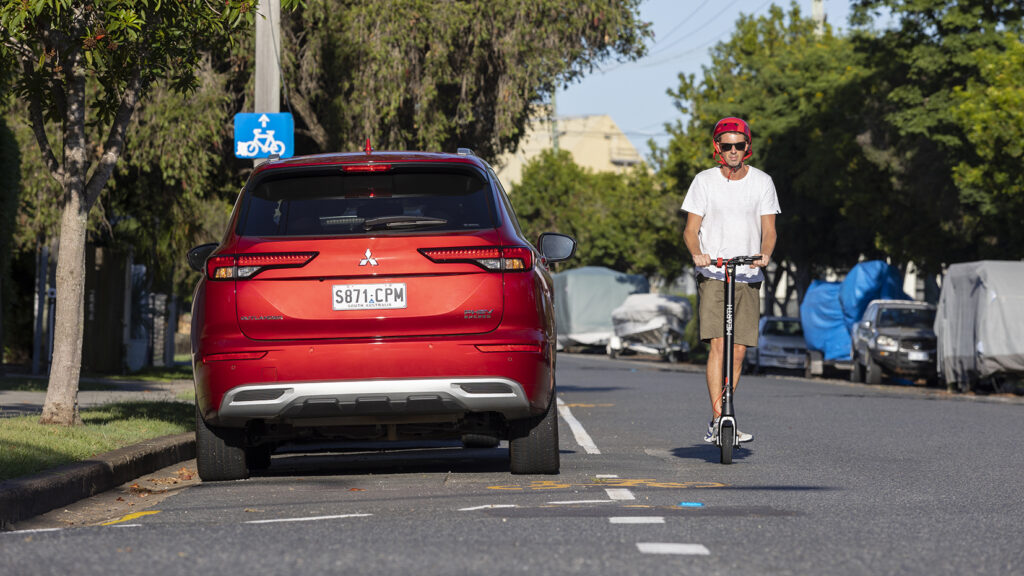
Good infrastructure determines whether you have an enjoyable, time-efficient e-scoot or not. In Queensland, a footpath or shared path has a maximum speed limit of 12km/h (the Mearth S makes a little beep when you reach this), while a separated path or bicycle path means 25km/h is allowed.
If the road has a speed limit of 50km/h or less, and a bicycle lane, you can use these up to 25km/h too. Local streets 50km/h or less and with no dividing line is also allowed up to 25km/h. All other roads are off limits.
My findings? Bicycle lanes are best – you travel at decent speed, the roads tend to be very well maintained, and you can often scoot a fair distance without stopping.
Footpaths aren’t so much fun. The surface is often uneven, there’s detritus from trees, kerbs to negotiate and lots of stop-starting. If pedestrians are using the footpath you must be really careful.
Older pedestrians, especially, hate you, your e-scooter and everything you stand for. They’ll let you know this with their angry glares, or, if you’re really lucky, with suggestions to fornicate off.
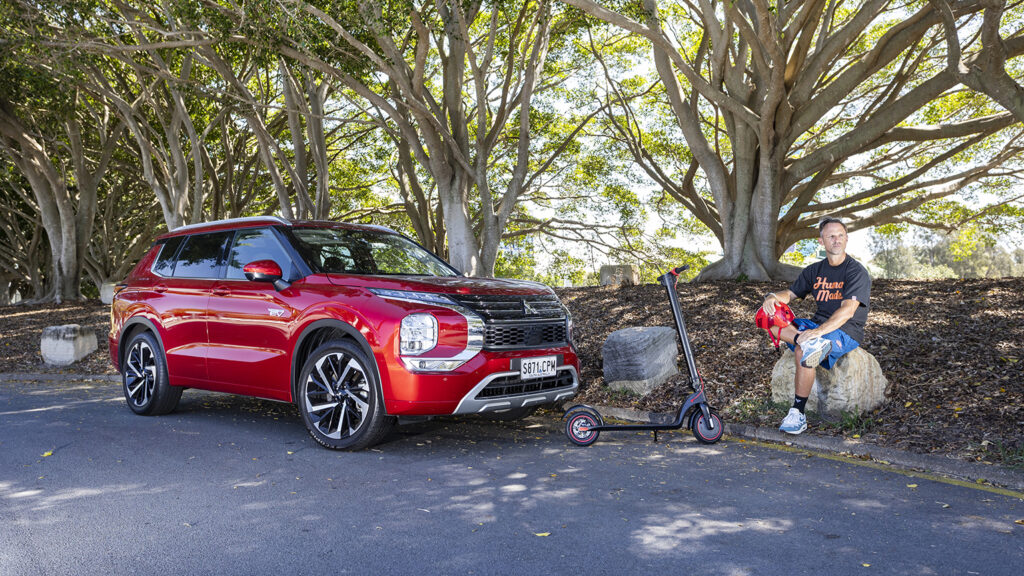
Another hazard is rival e-scooterers. Spend half an hour on one – especially our entry-level Mearth – and you realise you’re not alpha in the pack. Large, incredibly quick e-scooters (they’ve had their speed limiters removed… apparently very easy to do) fly towards or past you.
And, because electric, you don’t hear them coming. I’m going 12km/h like a good boy, then the neck-tatted, mullet-sporting shirtless legend flies past at 40, presumably late for a pharmaceutical collection.
Charging the e-scooter in the Mitsubishi PHEV
Negatives aside, I managed to travel the Gold Coast’s urban 4km in just over 25 minutes. I ducked behind the main roads and prioritised 50km/h limit residential streets, as this involved a lot less stop-starting.
The other major positive is the ease of V2L charging in the Outlander PHEV. Once back at the car I loaded the e-scooter into its boot and plugged in to the 1500W AC port.
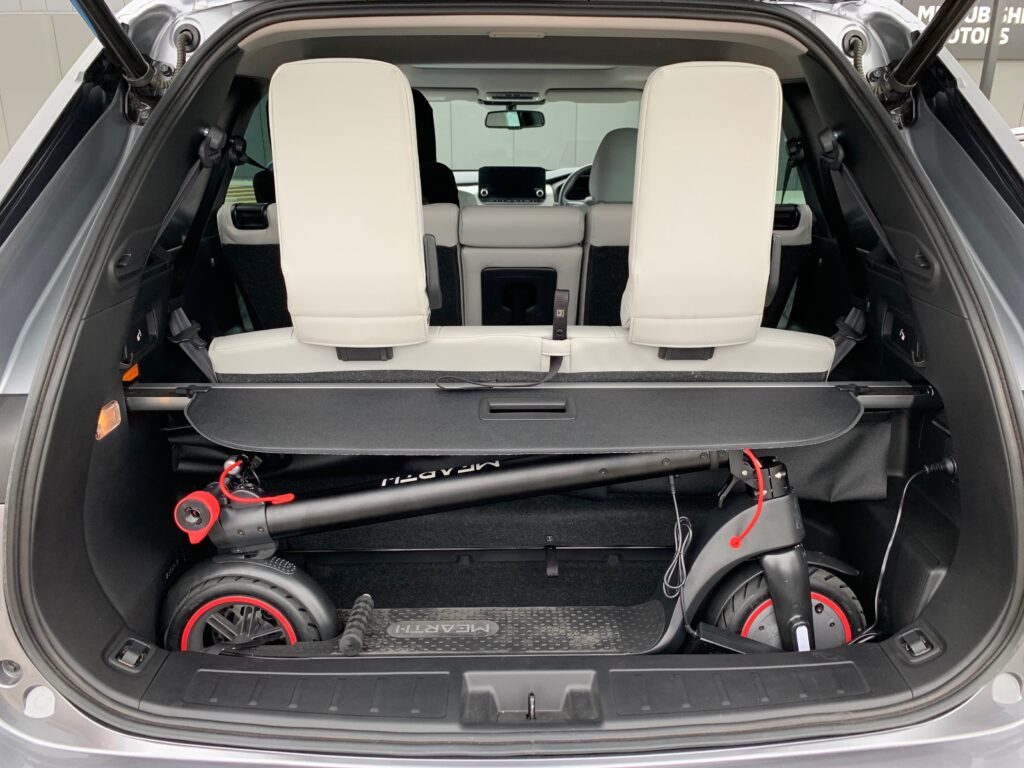
You must hit an ‘AC 1500W’ button on the dashboard’s control panel and when the light comes on, power’s provided. It’s really quite idiot proof. As the e-scooter’s battery is relatively small, it only drained a tiny portion of the Outlander PHEV’s 20kWh battery.
As an extra bonus, there’s another power point in the centre console. Mitsubishi makes the salient point that not only can you charge things like an e-scooter or laptop; as the PHEV acts like a mobile battery it can also assist in emergency situations like a blackout.
The Mitsubishi’s V2L ease of use certainly impressed – what could be simpler than just plugging in? It’s made me eager to test it out on a camping trip – powering a microwave, air fryer, coffee machine, pump for an air mattress and TV would make trips far more civilised. But not very ‘one with nature’. Our own Stephen Corby’s already tried it, and it did appear to bring a smidge more joy.
As for the e-scooter, the setup worked perfectly – it can be plugged in and charging in seconds. Mitsubishi’s managed to find a scooter that snugly fits the PHEV’s boot and still allows seven seats to remain in place. This drains what little boot space you have, but fold the third row of chairs and there’s ample space for luggage and e-scooter on board.
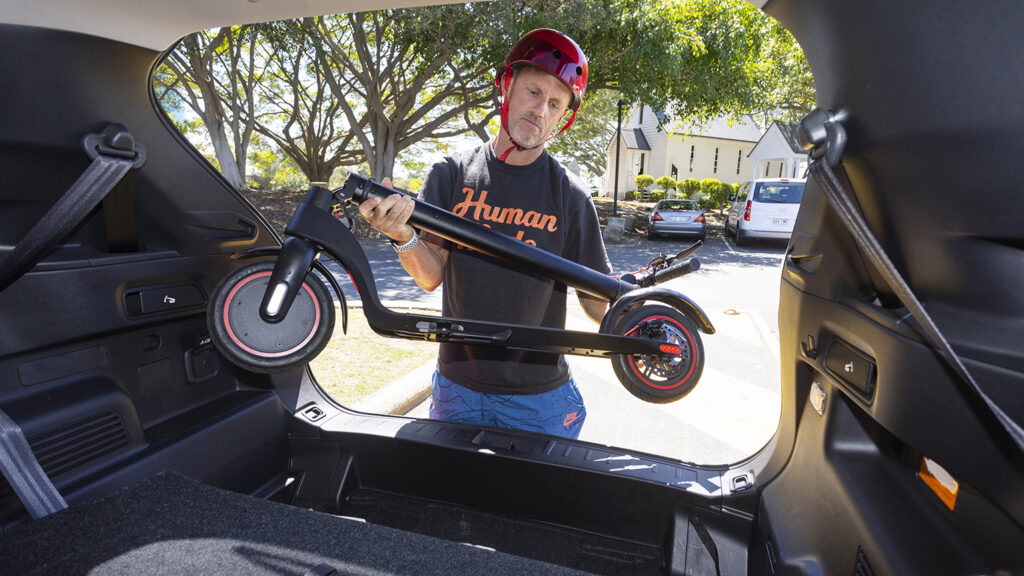
Poor planning and idiot riders
While this should be cause for Mitsubishi Australia to green-light making an e-scooter an optional extra for its V2L-equipped PHEVs, tighter controls around e-scooter use is the main stumbling block.
In a classic case of ‘this is why we can’t have nice things,’ since e-scooters arrived on our streets they’ve gained a reputation as hazards rather than the urban eco saviours excitable politicians were hoping for.
Sadly, laws (and fines) governing their safe use have come too late, and now in place, are often ignored and rarely policed. Infrastructure for safely using e-scooters is often poor, and on a weekly basis we hear of another tragedy involving riders being hurt or killed.
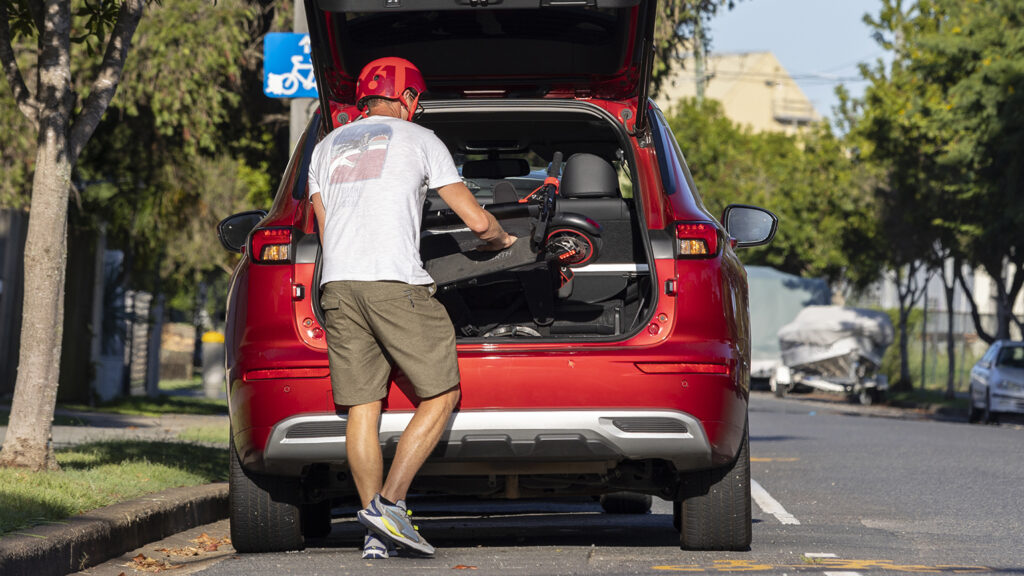
Private electric scooters are already banned on NSW and South Australian roads, footpaths and bike lanes, meaning they’re for use only on private property. Paris just made the news by banning rental e-scooters in the French capital – 90 per cent of votes cast supported a ban. These silent two-wheelers have quickly become public enemy #1.
Having been convinced by my Gold Coast experience, it’s easy to endorse the e-scooter ‘last mile’ concept. But it relies on riders doing the right thing, smart laws governing their use being applied, and governments and councils ensuring good infrastructure’s in place.
Sadly, it appears we’re a long way from any of these becoming a reality.
E-Scooter laws in different states and territories:
